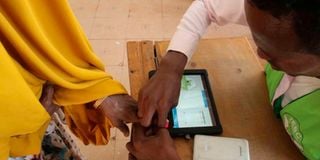Use technology to reduce election costs

A polling clerk uses a Kiems kit to identify a voter.
I was an election official during the last general elections and I witnessed so many unnecessary expenses which could be reduced if we embrace technology.
I dare say that those leaders who are against the use of technology are the ones who do not believe in free, fair and transparent elections.
Kenya can be emulated by other countries in Africa and beyond for conducting elections in the shortest time using the least number of employees and at a very low cost.
In my view we should do it this way:
The IEBC should establish a magnetic voter’s card similar to those used in banks.
Apart from identifying you, the card should indicate your ward, constituency and county. The card having all features to identify you can be used in any voting centre in the country. This means during voting day, one does not have to travel back home in order to vote.
This is not rocket science since banks use the technology for customers to withdraw money anywhere.
This card should be given to every citizen above 18 years whether in the country or abroad and should be given one month before voting day.
Computerised machines
Computerised machines should be developed so that once the card is inserted, it asks for features to recognise the voter, like fingerprints and eye contact.
Once you are recognised, photographs and names of all candidates vying for MCA will appear and you point at the person you wish to elect. Immediately you point, you have voted for that position.
MPs' photos will appear and you click with your finger your candidate of choice and so on up to the presidential candidates.
Once you are through with selecting your candidates, the voter’s card is absorbed into a safe storage box. This can be used later in case of a dispute.
This exercise can take as little as two to five minutes. As many machines as possible can be used to avoid queues. Issues about people with disabilities can be looked at separately but still within the latest technology.
The information should seamlessly be sent electronically to the ward tallying centre, constituency tallying centre, county tallying centre and national tallying centre. At the end of the voting time, the results should be unveiled and the total counts announced.
I believe so many expenses can be avoided if we go in this direction. Trials can be done during by-elections to establish effectiveness. Training and public participation should be held before the voting date.
These machines can also be hired out to other countries conducting elections to generate income for the commission.
Julius N. Gathage, Kisumu



